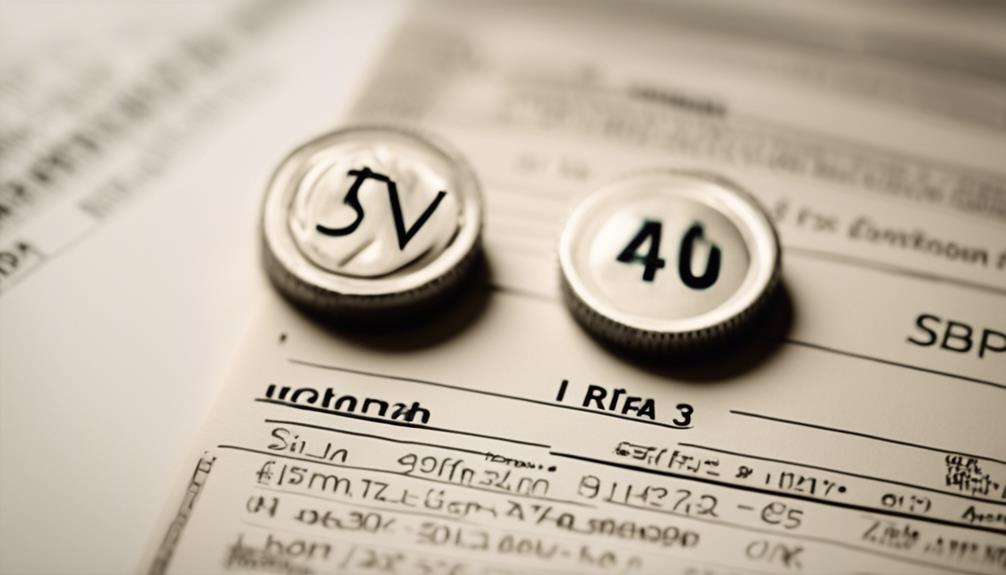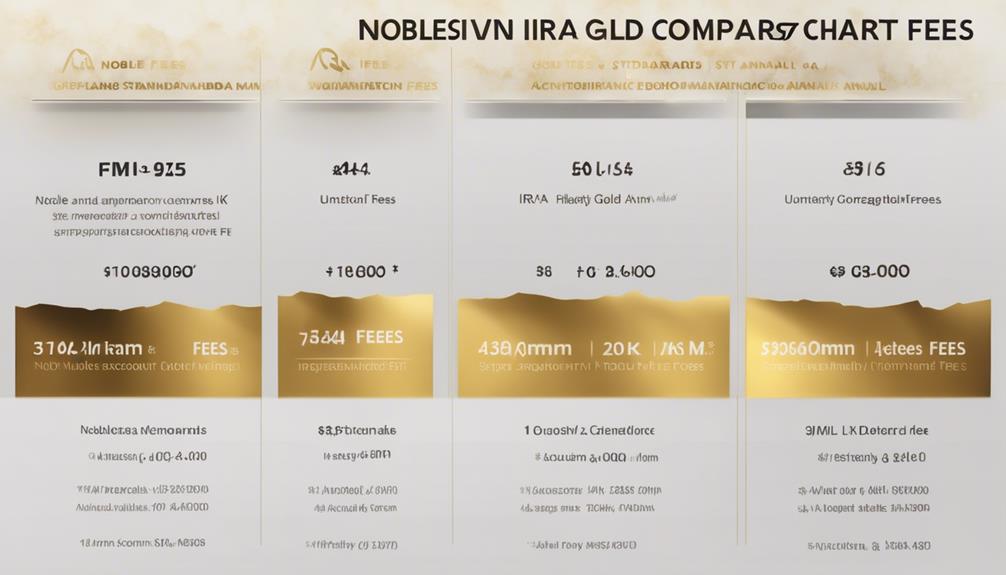Explore the intricacies of retirement savings by comparing Traditional, Roth, and SEP Gold IRAs. Gain an understanding of how tax treatment, contribution limits, and investment options influence your retirement plan. Traditional IRAs allow for tax-deductible contributions but taxed withdrawals, while Roth IRAs offer tax-free growth and withdrawals after retirement. SEP IRAs, designed for business owners, feature higher contribution limits and tax-deductible benefits. Educate yourself on the unique characteristics of each IRA type in order to make well-informed decisions that align with your financial objectives. Discover strategies for managing contributions and maximizing tax benefits. Identify important distinctions that could affect your retirement planning decisions significantly.
Key Takeaways
- Traditional IRAs offer tax-deferred growth and taxed withdrawals in retirement.
- Roth IRAs provide tax-free growth and withdrawals after-tax contributions.
- SEP IRAs cater to business owners with higher contribution limits based on compensation.
- Managing IRA contributions crucial to avoid penalties and maximize retirement savings.
- Gold IRAs allow physical gold holdings in retirement accounts with similar contribution limits as Roth IRAs.
Traditional IRA Deductions and Withdrawals

Understanding the tax implications of withdrawals from a Traditional IRA is crucial for individuals looking to save for retirement with tax advantages. Withdrawals from a Traditional IRA are taxed as ordinary income in retirement. This means that when individuals start taking distributions from their Traditional IRA, they'll need to pay taxes on the withdrawn amount based on their current tax bracket.
Additionally, Traditional IRAs have required minimum distributions starting at age 72, which individuals must take to avoid penalties. Being mindful of these tax implications can help individuals plan for their retirement more effectively and make informed decisions regarding their Traditional IRA contributions and withdrawals.
Roth IRA Contribution Limits and Benefits

Roth IRA contribution limits for 2023 stand at $6,500, with an additional $1,000 catch-up contribution for those aged 50 and above. Contributions to a Roth IRA are made using after-tax dollars, enabling tax-free qualified distributions in retirement.
Income eligibility thresholds determine the maximum contribution amounts individuals can make, offering tax benefits for those in higher tax brackets during retirement.
Roth IRA Contribution Limits
For individuals looking to maximize their retirement savings, understanding the current Roth IRA contribution limits is essential in planning for a secure financial future.
In 2023, the Roth IRA contribution limits are set at $6,500, with an additional catch-up contribution of $1,000 available for individuals aged 50 and older. These contributions are made with after-tax income, providing the benefit of tax-free growth and withdrawals during retirement.
Eligibility for Roth IRA contributions is based on income levels, with phase-out thresholds determined by filing status. Unlike traditional IRAs, Roth IRAs have no age limit on contributions, allowing individuals to enjoy tax-free withdrawals on qualified distributions.
Additionally, contributions to a Roth IRA may qualify for the Savers Credit, offering additional tax benefits for retirement savings.
Roth IRA Tax Benefits
Maximizing retirement savings becomes more achievable by taking advantage of the tax benefits associated with Roth IRA contributions. For 2023, Roth IRAs have contribution limits set at $6,500.
One key advantage is that contributions to Roth IRAs are made with after-tax dollars, meaning that withdrawals of these contributions can be made tax-free at any time.
Additionally, qualified withdrawals from Roth IRAs are entirely tax-free if specific conditions are met. This includes tax-free growth on investments within the Roth IRA, providing a valuable benefit for retirement planning.
SEP IRA Eligibility and Investment Options

SEP IRAs are reserved for business owners and self-employed individuals, offering higher contribution limits based on compensation.
These accounts allow for a range of investment options, including stocks, bonds, ETFs, and mutual funds.
Employers can contribute up to 25% of an employee's salary or $66,000, whichever is lower, into a SEP IRA.
SEP IRA Qualification Criteria
Business owners or self-employed individuals who've received at least $650 in compensation from their employer are eligible to establish a SEP IRA, allowing for contributions based on a portion of their compensation. This qualification criteria is essential for those looking to take advantage of the benefits SEP IRAs offer.
By meeting this threshold, individuals can open a SEP IRA and start saving for retirement through this tax-advantaged account. SEP IRAs provide flexibility in investment options, typically including stocks, bonds, ETFs, and mutual funds, allowing account holders to tailor their investments to their risk tolerance and retirement goals.
Understanding the eligibility requirements for a SEP IRA is the first step towards building a secure financial future through retirement savings.
SEP IRA Contribution Limits
After establishing eligibility for a SEP IRA, individuals can explore the contribution limits set based on compensation, providing a key aspect of flexibility and planning for retirement savings.
SEP IRA contribution limits are determined by the first $330,000 of compensation for 2023. These accounts, available exclusively to business owners and self-employed individuals, offer higher contribution limits compared to traditional or Roth IRAs.
Employers can contribute up to 25% of an employee's salary or $66,000, whichever is lower, into a SEP IRA. This higher cap allows for substantial retirement savings potential.
Additionally, SEP IRAs permit catch-up contributions for individuals aged 50 and older, enabling them to boost their retirement savings as they approach their retirement years.
SEP IRA Investment Choices
When contemplating investment choices for a SEP IRA, individuals have a range of options including stocks, bonds, ETFs, and mutual funds. SEP IRAs are available to business owners and self-employed individuals, with contributions based on the first $330,000 of compensation.
While SEP IRAs offer tax advantages and higher contribution limits compared to other IRAs, there are restrictions on non-publicly traded assets and investor-controlled assets. This makes stocks, bonds, ETFs, and mutual funds popular choices for SEP IRA investments due to their liquidity and diversification benefits.
It's essential for SEP IRA holders to contemplate their risk tolerance, investment goals, and time horizon when selecting from the available investment options to build a well-rounded retirement portfolio.
Tax Breaks for Traditional IRAs

How can individuals benefit from tax breaks when contributing to Traditional IRAs? Traditional IRAs offer tax deductions on contributions, allowing individuals to reduce their current taxable income. By contributing to a Traditional IRA with pre-tax dollars, investors can enjoy tax-deferred growth on their investments until retirement. Withdrawals from Traditional IRAs are taxed as ordinary income during retirement, providing a tax advantage at a potentially lower tax rate in the future. These tax breaks for Traditional IRAs incentivize individuals to save for retirement while simultaneously reducing their tax liability. It's important to note that Traditional IRAs have a contribution limit of $6,500 for the year 2023. Below is a table summarizing the key tax benefits of contributing to a Traditional IRA:
| Tax Benefit | Description |
|---|---|
| Tax Deductions | Contributions are tax-deductible, reducing taxable income. |
| Tax-Deferred Growth | Investments grow tax-free until withdrawals are made in retirement. |
| Lower Tax Rate | Withdrawals are taxed as ordinary income, potentially at a lower tax rate during retirement. |
| Contribution Limit | The maximum contribution for 2023 is $6,500, subject to annual adjustments by the IRS. |
| Retirement Savings | Traditional IRAs encourage saving for retirement and offer tax advantages to help build a nest egg. |
Retirement Plan Impact on IRA Contributions

Having a retirement plan at work directly influences the deduction amounts for traditional IRA contributions. Individuals with employer-sponsored retirement plans may experience reduced deduction opportunities when contributing to a traditional IRA. This impact stems from income thresholds and participation in workplace retirement plans.
Additionally, the ability to contribute to a Roth IRA alongside an employer plan may be affected by specific income levels. For Roth IRAs, contribution limits in 2023 and 2024 vary based on filing status and income.
Understanding how employer-sponsored retirement plans influence IRA contribution eligibility is important. It's essential to navigate these intricacies to maximize potential tax benefits and retirement savings.
Managing Excess IRA Contributions

The impact of exceeding IRS limits on IRA contributions can result in a 6% annual tax penalty and taxable earnings at ordinary income rates. Individuals who contribute more than the allowable amount to their IRAs need to promptly correct these excess contributions to avoid ongoing penalties. The tax implications of exceeding IRA limits can have a significant effect on overall retirement savings, making it important to address this issue promptly.
Seeking guidance from a financial advisor is highly recommended when managing excess IRA contributions. A financial advisor can provide valuable insights and assistance in handling the complexities of excess contributions, helping individuals understand the implications and take the necessary steps to rectify the situation. By working with a financial advisor, individuals can develop a strategic plan to manage excess IRA contributions effectively, ensuring compliance with IRS regulations and minimizing any potential financial repercussions.
SEP Vs. Roth IRA Main Differences

When comparing SEP and Roth IRAs, one must consider their key differences in eligibility and tax treatment.
SEP IRAs are tailored for small business owners and self-employed individuals, while Roth IRAs are accessible to a broader range of individuals.
Contributions to SEP IRAs are made with pre-tax income, whereas Roth IRA contributions consist of after-tax dollars.
Roth IRAs allow tax-free withdrawals at any time, offering more flexibility compared to SEP IRAs.
Taxes on funds in a SEP IRA are deferred until withdrawal during retirement, whereas Roth IRAs provide tax-free withdrawals under specific conditions.
Additionally, Roth IRAs don't mandate required minimum distributions (RMDs), making them more adaptable in retirement planning than SEP IRAs.
Understanding these tax implications is important when deciding between a SEP IRA and a Roth IRA, as they can significantly impact one's financial planning and retirement goals.
Advantages and Disadvantages of SEP IRAs

SEP IRAs present distinct advantages and disadvantages for individuals considering retirement savings options. One of the primary benefits of SEP IRAs is the higher contribution limits they offer compared to Traditional and Roth IRAs. This feature allows individuals, especially self-employed individuals and small business owners, to save more for retirement. In addition, contributions made by employers to SEP IRAs are tax-deductible, providing potential tax benefits for both the employer and the employee. This tax advantage can help individuals maximize their savings while reducing their current tax liabilities.
Moreover, SEP IRAs are particularly advantageous for self-employed individuals due to their flexibility in contributions, which are based on a percentage of compensation. This structure enables savers to adapt their contributions according to their income levels, offering a convenient way to save for retirement. Additionally, SEP IRAs don't have age restrictions on contributions, allowing individuals to continue saving for retirement without limitations, offering long-term savings potential.
Advantages and Disadvantages of Roth IRAs

Considering retirement savings options, individuals may find that Roth IRAs offer unique advantages and disadvantages worth exploring. One key advantage is the tax-free growth and withdrawals available after paying taxes on contributions. Since contributions to Roth IRAs are made with after-tax dollars, withdrawals are typically tax-free.
Additionally, Roth IRAs don't have required minimum distributions during the account holder's lifetime, providing more flexibility in managing retirement income. However, it's important to note that while withdrawals from Roth IRAs are generally tax-free if certain conditions are met, early withdrawals of earnings may incur taxes and penalties.
Also, to enjoy tax-free earnings, withdrawals must occur after reaching age 59½ and holding the account for at least five years. Understanding the tax implications, withdrawal rules, and contribution structure of Roth IRAs is vital for individuals planning their retirement savings strategy.
Comparing Gold IRAS With Roth IRAS

Both Gold IRAs and Roth IRAs present tax advantages for retirement savings.
While Gold IRAs allow investors to hold physical gold within their retirement accounts, Roth IRAs offer tax-free growth and tax-free withdrawals during retirement.
The contribution limit for both Gold IRAs and Roth IRAs is the same for 2023, providing investors with equal opportunities to save for retirement.
Additionally, both types of IRAs don't have an age limit on contributions, allowing individuals to continue saving as they grow older.
Contributions made to both Gold IRAs and Roth IRAs are eligible for the Savers Credit, which can further enhance the savings incentives for investors.
Whether investors prefer the tangible asset of physical gold or the tax advantages of a Roth IRA, both options offer unique benefits for individuals seeking to secure their financial future in retirement.
What are the benefits of including gold in a traditional, Roth, or SEP IRA compared to silver or platinum?
When it comes to choosing precious metals for IRA, gold offers a long history of stability and value retention, making it a popular choice for retirement accounts. Unlike silver or platinum, gold is a reliable hedge against inflation and economic downturns, providing a secure investment for the future.
Conclusion
To summarize, when considering the best IRA option for your retirement savings, it's important to weigh the benefits and drawbacks of traditional, Roth, and SEP IRAs.
Each type offers unique advantages and considerations, so it's vital to assess your financial goals and situation before making a decision.
Remember, like the branches of a tree, each IRA option has its own path to growth and prosperity in your retirement journey. Choose wisely and plan for a secure financial future.





